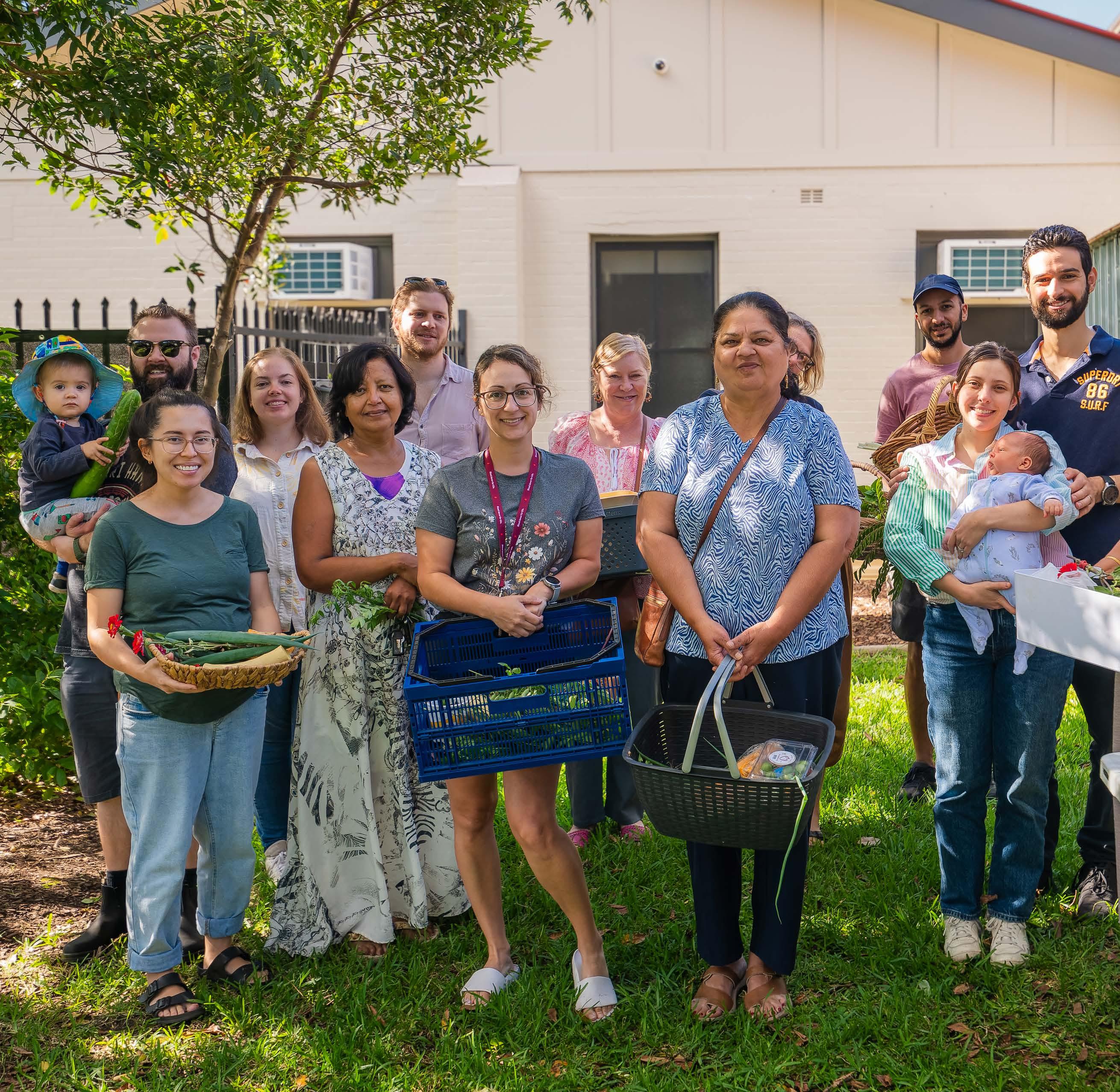
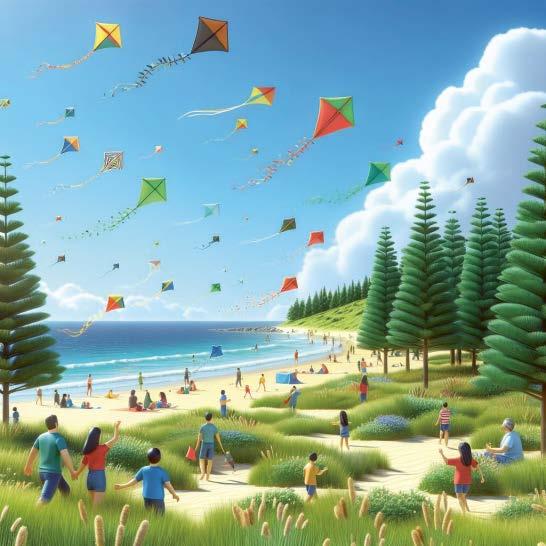







At the Dapto Ribbonwood Centre on Saturday, 10am-3pm

A new chapter for Comic Gong begins this Saturday, 24 May, with the celebration of all things comics, cosplay, gaming and pop culture to hit Dapto for the first time. Programmed and delivered by Wollongong City Libraries staff and volunteers, the annual celebration of comics, cosplay, gaming and pop
culture will feature a host of activities synonymous with the event –including cosplay competitions, trade stalls, arcade games, and live entertainment – all under one roof. Comic Gong is a free festival, which means there is zero cost for entry, activities and live entertainment. Click here for the program.
Saturday and Sunday at Coledale Community Hall

Coledale Community Hall’s delightfully retro interior is set to be transformed into a Vintage and Art Bazaar, with specially curated stalls offering one-of-a-kind art, handicrafts and vintage wares. Vintage clothes, toys, records and book sellers at the bazaar on Saturday 24th and Sunday 25th include Goldtone Vintage, Romance Revisited, Cass Jones
Vintage, The Bower, Juju’s, Fairly Ghetto Fabulous, and SCWC Good Books & Rare. At Saturday’s Twilight Market, High Speed Dubbing DJs will set the stage by spinning vintage vinyl and you can have your tarot cards read by Warrior Woman Oracle. The event is a fundraiser for the South Coast Writers Centre’s community writing programs.

24 May Fauré Requiem with Illawarra Choral Society 24 May Agony’ Exhibition Opening
25 May RSPCA Million Paws Walk
27 May Such a Resounding Silence screens

28 May Illawarra Health Professionals Unite for Gaza
31 May Anthology Launch & Poetry Award 2025
31 May-1 June
Thirroul Seaside and Arts Festival
4 & 5 June Short Film Festival Rescreening FREE
Share events to our calendar
By Tyneesha Williams
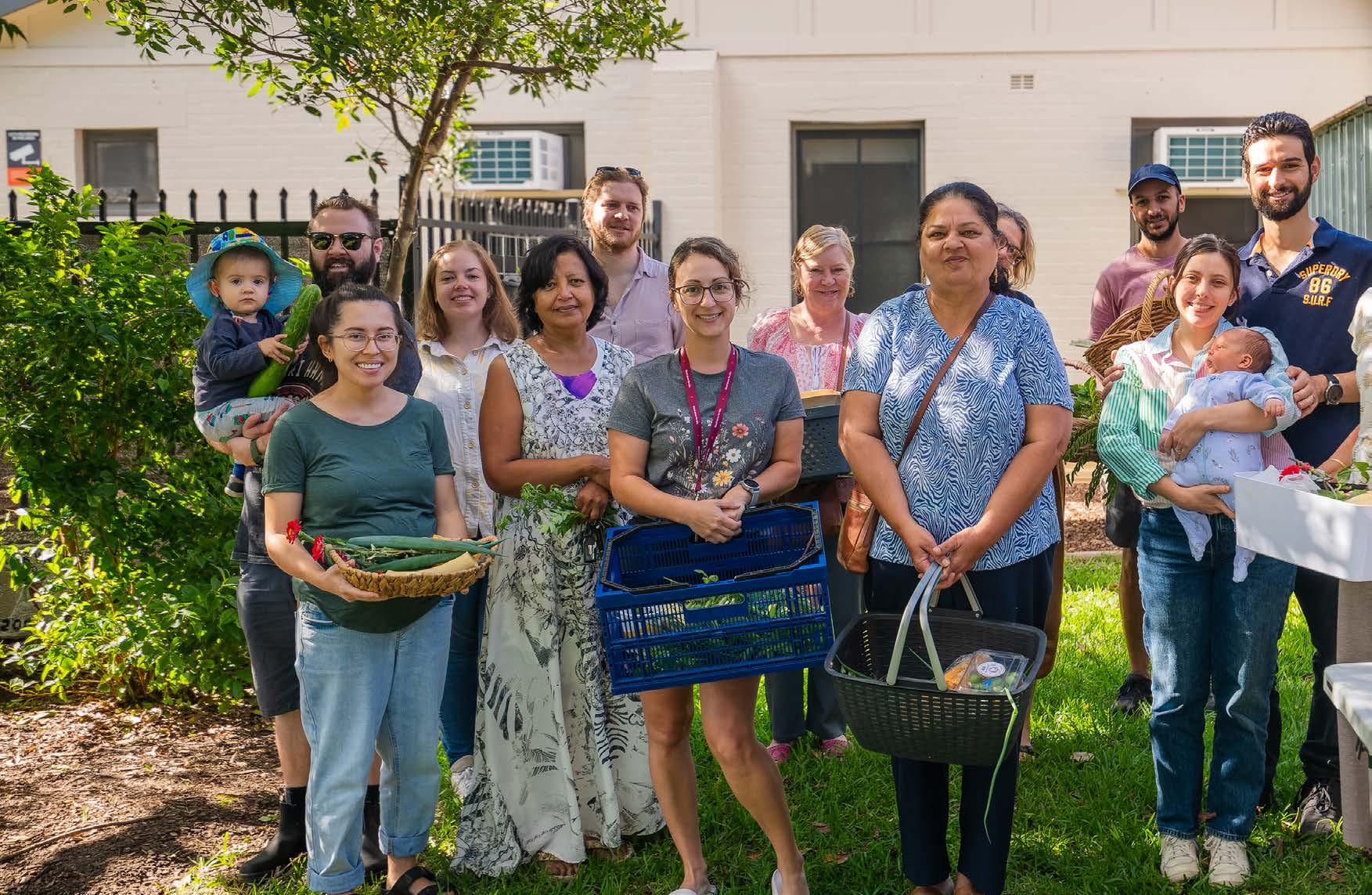
Monthlycrop swaps across the Illawarra are connecting locals with more than fruit and veg. Ester Neyers, who runs the Unanderra Crop Swap, says the events are a great way for people to connect with their local community.
“Our focus is very much on food plants. It’s not about ornamental plants. It’s squarely focused on enabling people to be self-sufficient,” says Ester, who holds the crop swap on the first Saturday of the month, from 10am at Unanderra Community Centre.
“Gardeners often have extras of things – they just can’t help themselves. It’s an opportunity to turn surplus into variety by swapping with other homesteaders and like-minded people.
“It happens very organically and no money changes hands, it’s a really nice vibe.”
While Unanderra crop swap involves a small group of gardeners who live in the area, it’s part of a growing global movement.
Crop swaps are also hosted locally at Kiama, Port Kembla, Thirroul and Bulli.
“With these kinds of events, small is beautiful.
“Anything more than, say, 18 people is probably too many. So we regularly get about 10,” Ester says.
“It’s good that it’s small and growing slowly because I think it’s a better event when people can take their time to stop and chat. It’s a really great group of people, everyone’s just really giving.”

“It’s an opportunity to turn surplus into variety by swapping with other homesteaders and like-minded people.”
– Ester Neyers
Crop swappers share gardening tips and recipes, contributing to a shared sense of community.
“There’s an endless opportunity for learning,” Ester says.
Crop swaps fit into a larger community push toward environmental practices as a response to the rising cost of living.
During last year’s Illawarra Edible Garden Trail, organised by Food Fairness and Healthy Cities Australia, local crop swaps opened to trail-goers.
“Gardening is a great teacher of delayed gratification, especially for kids seeing where food comes from. If people grew more of their own food, I think there would be a lot less food waste because they’re more invested in it and more likely to find ways of using it,” Ester says.
Born in Hungary, Ester experienced “early exposure to farm living as a child, and I think that’s probably fundamental in my love of the outdoors and growing things”.
As an adult, she lived in Sydney for 15 years, leading plant swaps in her role as a Sustainable Streets Officer at Marrickville Council, before moving to Unanderra.
“I worked with the community on implementing verge gardens,” she says. “I did that for about eight years.”
Ester has horticultural qualifications in bush regeneration and landscape design.
“I’ve worked extensively in natural areas with Landcare and Bushcare, and then I had a few years of involvement with Dapto Community Farm, where I leased a plot with a friend – and that’s where I got interested in growing food.”
Ester grows crops at home and says that winter gives gardeners the chance to upgrade their patch.
“It’s all a little bit dishevelled now, but I welcome the cooler weather because it’s time to renovate the garden, rejig things that aren’t working. The garden’s never really finished.”
Ester has recently started keeping bees.
“It brings me a lot of joy. It’s just funny to think that the things that bring me the most joy are the things that make me no money.”
Recently Ester had to miss a Saturday swap – though she sent her homegrown pumpkins and herbs along – and was glad to hear the event ran well without her.
“I’m so pleased that people have stepped into that leadership role, that really warms my heart, that people see the crop swap as their own,” she says.
“It’s not just my crop swap, it belongs to everyone and I feel confident that it will continue for the foreseeable future.”
To find a crop swap near you, visit the Food Fairness section of Healthy Cities Australia website


By Amanda De George

“Whales have already been spotted off our coast and the numbers will only increase”
– Amanda De George
Ice-cold temperatures and rain; it’s enough to have you bundling up and hibernating the season away. Add in wine, a good book and throw in a roaring fire for good measure and facing the brisk weather sometimes feels nearly impossible. But we’ve got three absolutely unmissable wildlife experiences to tempt you out into nature, no matter the weather.
Still time to be a fun-guy or gal
What: Look, I’m in my fungi era. And while the mushie season is drawing to a close – Autumn is the prime time –there’s still loads around. This isn’t about looking for fungi to eat but to just enjoy the thrill of finding all the incredible shapes, colours and sizes – some of which are absolutely mind-blowing – of local fungi and slime moulds. Where: Everywhere! Mulch piles, decaying tree branches and amongst moist leaf litter is a great place to start.
Dance like no one is watching
What: From May/June to around August is the peak display period for the Superb Lyrebird. Not only will you hear them cycling through the mimicked repertoire of local birds (both the males and females are extraordinary mimics) but
you might get lucky and spot a male trying to woo a mate. Up on his dirt podium – one of up to 20 he builds in his territory – tail fully extended and tossed forward over his head, he vibrates and literally shakes his tail feather(s) towards the waiting female. Who wouldn’t be impressed with that?
Where: Sublime Point, Mt Kembla and Mt Keira Ring Tracks and Minnamurra Rainforest are all great spots to see this incredible dance.
Whale hello there!
What: May is officially the start of the Humpback Whale northern migration. The migration back south from around October gets a lot of the glory thanks to the active newborn calves that accompany their mums back home but there’s a lot to love about the start of the journey. Competition pods are really exciting to watch. Males compete with each other to grab the attention of a female humpback as she heads north to breed. There’s loads of argy bargy during this process, with the males swimming at a frantic pace, jostling each other out of the way and often trumpeting loudly! Where: Find your nearest headland and wait (with a coffee). Shellharbour, Wollongong lighthouse, Bulli and the Royal National Park are all prime spots.

HammondCare is a leader in health and aged care. We’re seeking compassionate people like you to bring comfort and connection to people living at home or in residential care in the Illawarra region.
Regular visits from volunteers can help reduce isolation, providing support and connection outside of their usual routine. Volunteering is a rewarding experience, so come and share your time, skills and compassion to brighten someone’s day. Volunteer with HammondCare and help change lives
Types of volunteering:
• Social home visits
• Bring your pet
• Gardening
• Board games
• Treats trolley
• Mini van drivers
• Men’s shed
• Pastoral care
For more information: 1800 79 33 99

volunteer@hammond.com.au hammondcare.com.au/ volunteer

By Emma Rooksby of Growing Illawarra Natives

Afewweeks ago, Backyard Zoology
had a wonderful article about finding a bandicoot in her backyard. What good fortune to have these amazing creatures around us in the Illawarra.
Each of us who has a little patch of ground to play with can help provide safe havens and habitat for local fauna, including bandicoots.
The bandicoot to be seen around the Illawarra is the Long-nosed Bandicoot (Perameles nasuta) and it lives mostly in rainforests, tall eucalypt forests and grassy woodlands.
The Illawarra escarpment is the most likely place where you might encounter a Long-nosed Bandicoot, thanks to the relatively large areas of remnant and recovering vegetation that is suitable for this species.
So if you live anywhere along the escarpment, particularly in the upper
reaches or near the State Conservation Area, you may have areas that are home to bandicoots, or could be adjusted to host them.
Some useful things to know about these bandicoots. They live in our local forests and eat the very wide range of foods that occur there, such as fungi (including underground truffle-type fungi), insect larvae and insects, fruit and seeds, leaves, and even small lizards.
So recreating the forest habitat that contains all these elements will provide a natural bandicoot larder.
As well as planting a wide range of local plants, you can also provide habitat by leaving fallen logs and branches to rot down and be consumed by fungi, leaving areas of mixed meadows for foraging, letting native grasses go to seed rather than mowing, and protecting some or all of your garden from domestic pets or other animals.
Long-nosed Bandicoots are nocturnal, so you’re much more likely to see them moving around at night.
Keeping night lighting to a minimum is beneficial for the animals, however. If you want to go bandi-spotting in your backyard, the best option is to cover your torch light with red cellophane or a red filter, as this disturbs them less.
In the light of day, signs of bandicoot activity include conical depressions or holes in the ground where they’ve inserted their long, narrow snout to extract insects or fungi.
The wide range of trees, shrubs, vines and groundcovers that form the forests of the escarpment can be mixed and matched in escarpment gardens. The Growing Illawarra Natives website, which I help manage, provides guidance on suitable species, and lets you select plants that meet your aesthetic preferences as well.
Once upon a time, not so long ago, the Long-nosed Bandicoot was common across the Illawarra Region, and would have benefited from Dharawal people’s care for Country. With the increasing urbanisation of the coastal plain in particular, the species has become more or less extinct.
Norm Robinson recorded them in Yallah, just south of Dapto, in the 1990s,
but found that they had become locally extinct in the Keiraville and Gwynneville areas. As West Dapto is urbanised, it is likely that the Long-nosed Bandicoot will struggle unless significant areas of suitable habitat are retained.
Larger intact areas such as Saddleback Mountain would still retain good populations.
If you’re lucky enough to live in that area, protecting and restoring as much native vegetation as possible will benefit bandicoots and, of course, many other other native animal species.
Pictured below is an area with a mix of low ground covers producing a range of fruit and seeds – this would be a good component in a garden designed for Long-nosed Bandicoots. Also pictured is the fruit of Hairy Clerodendrum (C. tomentosum), a rainforest shrub or small tree that is common and widespread across the region, and produces abundant fruit in good years. This species is a useful component in gardens in areas that would once have contained rainforest.
Pictured at left: A long-nosed bandicoot, photographed in Sydney. (By JJ Harrison - Own work, CC BY-SA 3.0.)
Below: Images by Emma Rooksby.

“Each of us who has a little patch of ground to play with can help provide safe havens and habitat for local fauna, including bandicoots.”
– Emma Rooksby

By Genevieve Swart

Shocked by the enormity of land clearing for the $390 million Mt Ousley interchange upgrade, residents have banded together in a group called Save Our Trees.
“It’s a social media group of about 40 local residents who discuss the local issues, and try and use that group to represent a collective community view into the project,” said Ian Rosier, a founding member who lives near Bass Park, within 100 metres of Mt Ousley Rd.
The interchange at the foot of Mt Ousley will replace the existing intersection of the Princes Motorway and Mount Ousley Road. Consultation began almost a decade ago and Ian – a software developer who works from home – has been involved from the start, providing suggestions on and off. But when bunting went up last October, and he discovered the tree clearing would be much more extensive than expected, everything changed.
Residents started calling construction contractor Fulton Hogan’s hotline, asking: ‘What’s that bunting for?”
“They said, ‘Yeah, well, all of that area’s going to be cut, obviously.’ And we’re like, ‘What the hell?’”
Then, last October, Ian went to a public meeting “which just confirmed our worst fears”.
Dozen hectares to be felled Ian describes the project’s Review of Environmental Factors (REF) as a 1500-page “stitch-up”.
“The end result is that 12.7 hectares of trees are just going to be clear felled. And what that represents in this green belt, adjacent to the interchange, is really 90% of the vegetation there is just deleted off the face of the planet.
“I feel devastated and a huge sense of loss and disempowerment – as a resident, I’m very emotional about it.”
Ian watched an early round of tree felling, sharing footage on YouTube. “It’s just heartbreaking. These machines just come down the street and they just eat the trees. These mature trees, which are 60 years old or more in some cases, they just cut him down with his giant machines, drag it up the street, throw it in the mulcher, and it’s gone.”
Numerous studies show the health benefits of trees in suburbia, including a 2019 UOW report revealing adults in leafy neighbourhoods have a lower risk of developing psychological distress. Study co-author Associate Professor Xiaoqi Feng said, “Walks through green space have been shown to reduce blood pressure, improve mental acuity, boost
memory recall and reduce feelings of anxiety.”
Ian now has his own list of leafy benefits, including protection from dust, pollution, wind, heat and noise.
“It’s shelter when you get under the shade, either riding a bike or walking. It’s protection from the effect of car lights and street lights on the Mt Ousley Road.”
Trees suppress weeds and keep litter out, as motorists driving down the pass dump KFC or McDonald’s rubbish, he said. “We’re forever picking those up. But it stays on the road when the trees are there.
“When the trees are mature, as they were, it’s a place of nature with birds, reptiles, possums.”
Now the vegetation barrier is gone, Ian said: “We’ve got a lot more dust and dirt on our windows and patio and solar panels. We hear a lot more noise, we see a lot more lights.”
Ian said the tree felling is affecting locals’ mental health.
“Mental health around this is quite serious. Almost everyone on our group, we care about the trees, we nurture them, we pick up rubbish. We’ve got a nice park here where we share occasions, and we feel like all of that has been disrupted.
“We can’t understand by what authority in this day and age with climate change, and other things, how this has been allowed to happen.”
Call to revegetate local areas
Mt Ousley is a state road, so Transport for NSW (TfNSW) is responsible for the
interchange project, not Wollongong City Council.
However, Ian said, as council has a tree canopy cover target of 35 percent, he’s mystified as to why the project doesn’t include a commitment to no net tree loss in the local community.
“You would at least expect to have some sort of an offset,” he said, also acknowledging there’s no one-for-one solution.
“A seedling is nothing like a mature tree. The replacement value is something you might get in 30-plus years.
“It was an important green belt … we should be pushing to have it replaced.”
In 2019, when Endeavour Energy flagged 1300 street trees growing close to powerlines as candidates for removal, it ran an offset program with Greening Australia. A spokesperson at the time said Endeavour had trialled the program in 2018, removing 767 trees and replanting 27,000 new ones, as well as a new community garden in Dapto.
Transport for NSW responds
Responding to questions, a TfNSW spokesperson issued a statement, saying: “The Mount Ousley interchange project team has measures in place to ensure only necessary vegetation is removed during work, and to minimise any environmental impacts.
“Transport and Fulton Hogan will revegetate as soon as possible.”
Read more on our website

“You would at least expect to have some sort of an offset … It was an important green belt … we should be pushing to have it replaced.”
–
Ian Rosier, Save Our Trees

By Andy Lawrence

“It felt like it was me and my husband against the tidal wave of the system.”
– Andy Lawrence
Theseeds of influence that would bloom into my first homebirth were sown during my pregnancy with my first child. She was born at Wollongong Public Hospital in the waterbirth tub after an induction. My experience was both incredibly empowering and isolating. Fragmented, non-continuous care experiences throughout pregnancy and birth with disrespectful care providers and a lack of external support meant that I felt very alone in my decision making. It felt like it was me and my husband against the tidal wave of the system.
During that pregnancy, I came to understand that continuity of midwifery care was the gold standard model that
produced the best outcomes and experience for women and their babies. I also began osmosing information about physiological birth. That is, birth as an evolutionary, mammalian design and the ways our birth imprint has been impacted by our culture of birth-fear and the medicalisation of women’s bodies. You only have to pick a topic from the following (inexhaustive) list to begin down the rabbit hole of all the ways our patriarchal western culture has derailed the biological blueprints of women’s bodies: Menstruation; The pill; Menopause and the cultural lambasting of angry, menopausal ‘Karens’; Birth and the cascade of intervention; Endometriosis; Other chronic illnesses
such as chronic fatigue and the historical dismissal of women’s pain; I could go on… I baulk at taking paracetamol unnecessarily, and my mother had birthed four children naturally, seemingly with as much ease as birth can offer. So, a planned caesarian or epidural was never really on the cards for me. It wasn’t part of my familial blueprint.
Early in my second trimester, I read a book that amplified my interest in physiological birth into a full-blown feminist passion. The book was Ina May’s Guide to Childbirth. It was written by Ina May Gaskin, an American midwife whose experience has culminated in decades of work in supporting out-of-hospital physiological birth. The midwifery centre she founded, and in which she continues to work, touts an astoundingly low caesarean rate of 2% across approximately 3000 births. This is compared to a 38.4% caesarian rate in NSW in 2022 (49.4% in privately insured mothers) across 91,634 births. The national rate is roughly the same at 39%.
Obviously these statistics are barely comparable given that the women at Gaskin’s centre are self-selected and screened by the midwives. Additionally, there are 30 times more women birthing in the hospital system in a single year in NSW than in Gaskin’s birthing centre across several decades. However, the sentiment remains. The World Health Organisation (WHO) recognises that when the caesarian rate of a country exceeds 10%, improvements to maternal or foetal mortality cease. So, do 40% of Australian mothers really need a caesarian to birth their babies? And if not, why is the rate so high?
I digress, but I can’t help it. The state of birth in our maternal system makes little logical or evidence-based sense and hospital caesarian rates are just one lens through which to dissect the flaws.
Anyway, the book kindled a fire that later saw me becoming a doula myself to give women an option for continuity of care in a fragmented system. Hiring a doula for my first birth would have allayed the feeling of angst and isolation
we felt navigating the medical system. The book also sparked an interest in homebirth. By the time I was postpartum with my daughter, I already knew my next birth would be a homebirth.
Prior to this time, I had no exposure to homebirth. I knew it happened but it didn’t appear in my realm of possibility because I didn’t know anyone who had had one. I began following doulas and midwives on Instagram and slowly increased my exposure to homebirth so it no longer seemed like such an ‘alternative’ option. It became the option.
Homebirth is not new, the information on its safety exists and the stories and experiences of women who have birthed at home like myself stand tall. So how do we push back against the tide of fear and the cultural impetus for control over birth and women’s bodies?
Our exposure to birth has become warped by western cultural ideals of disconnection and vice-gripped control. In hindsight, I think one of the most radical acts of my life has been having a homebirth. Not just the birth itself, but also the way it’s impacted how I relate to birth. That’s not to mention the maternal support work I do in the community that was catalysed by that journey.
Because of my choices, each person in my circle now knows someone who has had a homebirth, they have been exposed and that has a ripple effect. I know I have directly influenced at least two friends across two different countries to opt for homebirth and many others whose edge of judgement has been blunted by my story, even if they would never make the same choices as me.
Just like me, the women I know who have had home births opted for the journey of self-reclamation that so often accompanies the decision to birth at home. To swim against the current of birth-culture is to begin to understand all the ways we have been taught to fear birth and pathologise our bodies. Because of this, the path to homebirth often involves healing and reclaiming one’s voice and bodily autonomy. It can awaken a fire, long dampened by the weight of wet patriarchal boots.
An opinion piece by Nicky Sloan

Latelast year I looked at the world and I got a bit despondent. The American people had spoken and they said “We want an orange buffoon to run the country”. They elected a man who was not only a convicted criminal – but an unrepentant convicted criminal. A self-confessed abuser of women and a hater of paper straws.
At the same time we saw some terrible racist rhetoric in the discussion about the tragedy that is the war in Gaza. We’ve seen a reversion to two genders in America and the forced expulsion of innocent people. And then just in recent weeks, we’ve seen the weaponisation of Welcome to Country AND The Voice for electioneering purposes.
Community Industry Group is an
organisation founded on the principles of social justice. We cast a social justice lens over everything we do. A fairness lens. A kindness lens. And I saw it was being a bit neglected in the public lens.
So we decided to host a conversation about social justice. And last week we hosted certified Aussie legend Craig Foster to lead the conversation at a luncheon in Wollongong. That conversation is also available as a free podcast/vodcast as part of our Community Matters series.
Craig grew up in country NSW and had a very white, middle-class existence until he was recruited to the national youth representative soccer team. There he was exposed to a broad range of cultures and backgrounds. As a
professional soccer player representing and captaining the Socceroos, Craig travelled the world and learned about diversity and equity.
Craig took his newfound understanding and used his fame for good by becoming a human rights advocate. His high-profile campaigns include rescuing a young Bahraini refugee from a Thai prison and helping many Afghan women and girls to flee the Taliban in 2021, including the Afghan women’s national football team. He also led the successful ‘Game Over’ campaign with Amnesty Australia to free hundreds of refugees trapped in Australia’s offshore detention regime.
As chair of the Players Association, Craig championed equal pay in Australian football. I’m sure the Socceroos are happy that they supported equal pay, as now all sponsorship and prize revenue is shared equally between them and the Matildas!
In the podcast, Craig speaks candidly about the need for systemic change and the courage required to challenge entrenched power structures. He recognises that advocacy is not always easy and reflects that resistance is a natural and expected part of progress.
Craig’s message is that we all have the ability to influence change. He issues a call to action grounded in empowerment and personal responsibility. In the podcast he speaks about his belief that all people are guided by an innate sense of justice. He urges us all to reflect on our
own responses to inequality by posing the powerful question: “What would you do?”
Craig’s insights inspire reflection, empathy, and the courage to act –making this episode of the Community Matters podcast essential listening for anyone committed to building a fairer and more inclusive future.
For someone who has achieved so much, he is remarkably humble. I encourage everyone to tune in and be inspired by this Aussie legend.
Nicky Sloan is committed to working to build a fair and inclusive community where all people are valued and enabled to live rewarding lives. She is the CEO of Community Industry Group and has extensive experience across the community services industry. Her diverse work history also includes local government, marketing, the tertiary sector, the finance sector, and owning and running small businesses. She has extensive governance experience and is currently an Independent Non-Executive Director of Warrigal, a substantial not-for-profit specialising in the provision of services for older people and Chair of the Board of Wollongong Conservatorium of Music.
Part of the Community Matters podcast series, Nicky’s interview with Craig is available on YouTube, Spotify or Apple iTunes
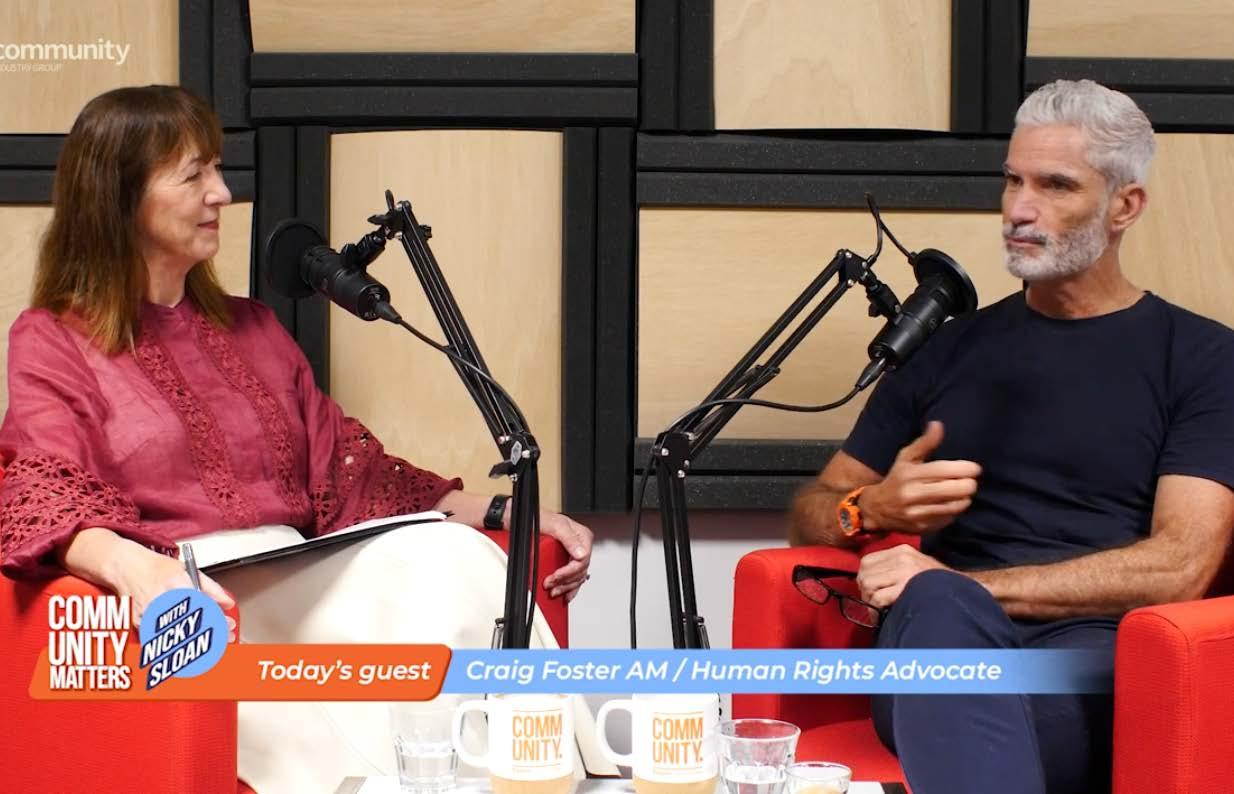
“I’m sure the Socceroos are happy that they supported equal pay, as now all sponsorship and prize revenue is shared equally between them and the Matildas!” – Nicky Sloan
Visitors seized the moment at Fire and Rescue’s Open Day. Click to read more, photos by Tyneesha Williams
Yes, I’ll hold a hose








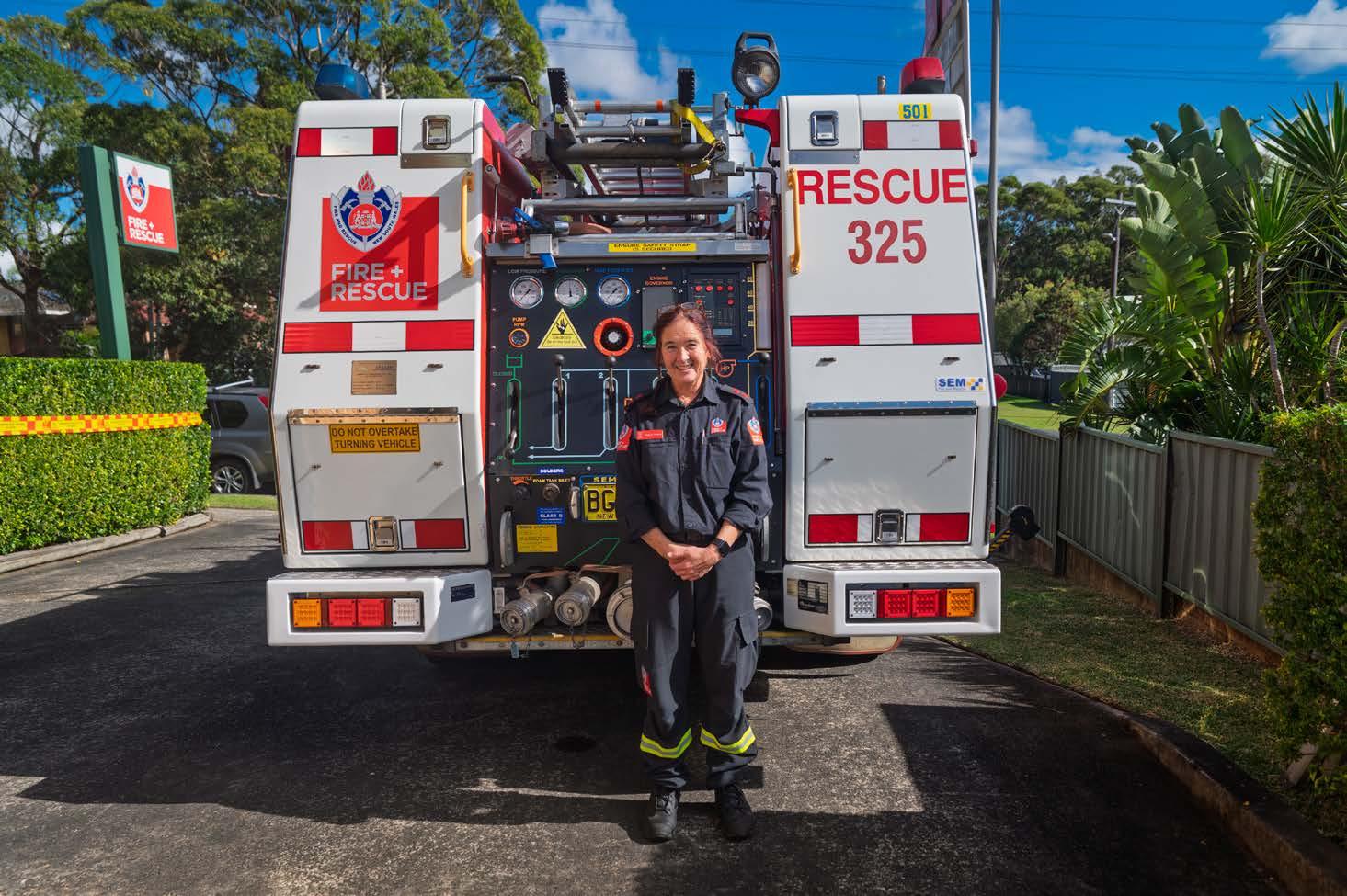


On Saturday, May 10, local fire stations welcomed families for NSW Fire and Rescue Open Day. Visitors were invited to grab a sausage sandwich, explore the firetrucks, have a turn on the hose, collect show bags and sign up for free fire detector installations. The Illawarra Flame visited stations at Helensburgh, Coledale and Thirroul, and visitors shared their thoughts. Click here to read more
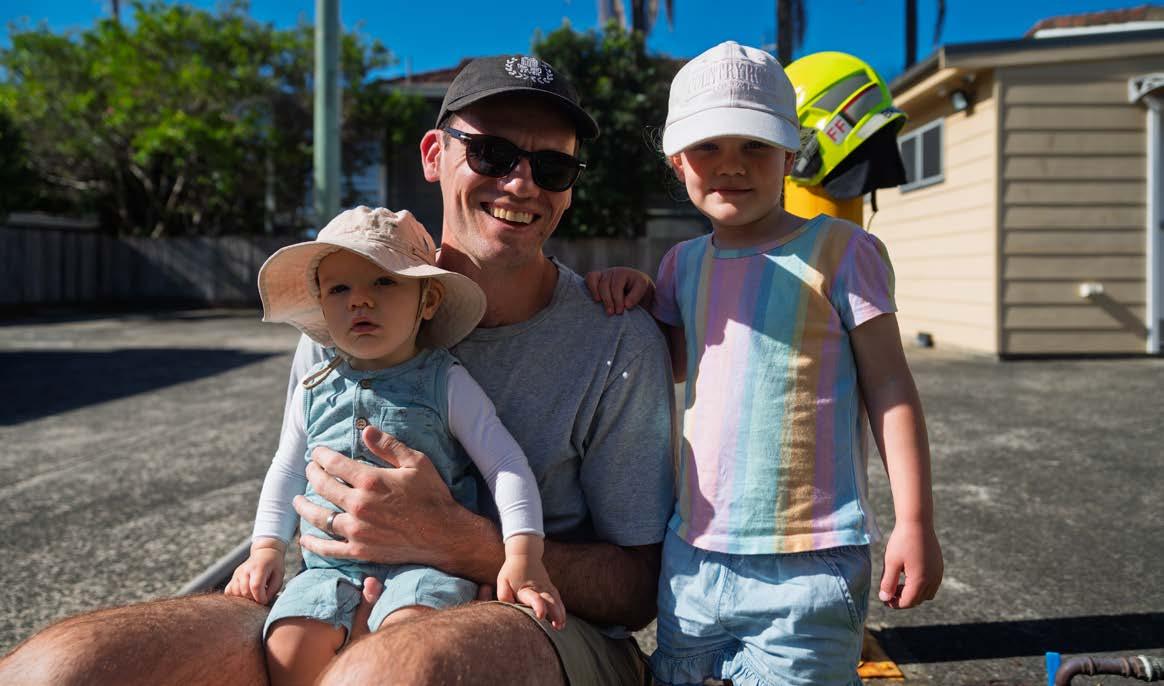
By Genevieve Swart

RideWollongong Festival of Cycling has huge potential as an annual event, with riders and businesses eager to celebrate the Gong’s status as Australia’s first Bike City.
This year’s event – held last Sunday at Lang Park – featured a new flagship charity, with Ride4Rotary raising funds for much-loved local organisation Southern Youth and Family Services (SYFS), which supports disadvantaged youth and their families, including people who are homeless or at risk of being homeless.
The annual cycling festival – a legacy of the 2022 UCI Road World Championships – also featured food stalls and a community expo with the likes of Illawarra Bicycle Users Group (iBUG), a member-based volunteer organisation affiliated with Bicycle NSW.
iBUG president Ed Birt described Sunday’s turn-out as “disappointing” but said overall Ride Wollongong was a feel-good affair, with three rides setting off at 8am and an all-abilities family ride around the lighthouse at 10am.
Cunningham MP Alison Byrnes and Wollongong MP Paul Scully attended the official opening of the festival.
“We got to have a good chat with them about active transport, which is all good,” Ed said. “And met some nice people, got a few additional members on
board for iBug, and sold a couple of T-shirts even. So all in all, it was a good day, but it was just a very, very quiet day.
“There really wasn’t many people there at all.”
While community rides went ahead, organisers had already, with “much disappointment”, cancelled 2025’s races: the Tour De Gong time trials and criterium. “Despite our best efforts to promote the event through direct outreach, email and social media, registrations have remained much lower than expected, making it financially unviable to proceed. We understand this is disappointing news, and we sincerely apologise for any inconvenience caused,” the website post read.
“If it wasn’t for those communitybased rides, it [attendance] would have been even worse,” Ed said.
In an email, Mark Emerton, CEO at event organiser Elite Energy, described the day as a “great success”.
“Although a little chilly and thankfully no rain, the numbers were up from last year, and with the Ride for Rotary aligned, we certainly had lots of happy riders and families.”
SYFS youth support worker Jason Saladino was happy with the outcome, saying: “The day itself was a great success and we had a record number of 198 people registered to ride in Ride4Rotary
across both our virtual and live events.”
SYFS has a revised target of $55K with the fundraising portal open until Sunday, May 25. There is still time to help SYFS achieve its target – simply click the ‘donate’ link (below left) to help fund SYFS’s critical employment, education and training programs for young people.
Next year iBUG president Ed Birt would like to see a more collaborative approach to planning the event. “The lesson to me is that the focus needs to be on bringing the community into it more effectively, broadening the appeal.”
iBUG members have suggested bringing in cafes and breweries, live music, more arts and culture tie-ins, activating bike paths and putting on bike-themed event across the city.
“I think we can have a really great weekend. We don’t want to lose it, but it’s just not quite hitting the mark yet,” Ed said. “We can definitely do better.”
Ride Wollongong had a controversial start in 2023, when the event launched with a publicity stunt featuring the then Lord Mayor Gordon Bradbery riding a tandem bicycle with a coal miner from event sponsor South32.
The launch stunt – held about two weeks after the mining company agreed to a record $2.9 million payout after draining water from the Sydney catchment without a licence – attracted publicity for all the wrong reasons, with a Climate Council expert calling it ‘sportwashing’ and locals dubbing it a ‘bikewash’.
South32 has since sold its Illawarra assets to GM3 but unease in the climate-conscious cycling community remains. “We’ve got a pretty savvy citizenry these days,” Ed said.
“iBUG has many members who flat out refuse to participate, and essentially
silently boycott the event due to the sponsorship of a cycling event by a fossil fuel company. It’s pretty tone deaf and while I realise sponsorship dollars are hard to come by, if we want these events to be a success this is a definite consideration.
“You wouldn’t have a vegan festival sponsored by the beef industry – a large proportion of cyclists are concerned about climate change and the effects on the environment of our continued reliance on fossil fuels so I would suggest alternative sponsorship would be a great idea if we really want a broad base of participation in the event, which ought to be an inclusive celebration of cycling for our city.”
Sunday’s event shut several city streets so riders could safely navigate the 10km, 20km and 29km routes, with closures in place from 7-11.30am on Endeavour Drive at Cliff Road, and Marine Drive between Cliff Road and Crown Street. Ultimately, it’s hard to say why participation was not better. Was it predictions of rain (which held off), a silent boycott or something as simple as a lack of publicity?
“Many people I spoke to said they hadn’t seen anything about it,” Ed said. “They didn’t know it was on.”
In the lead up to the festival, Wollongong City Council – which funds Destination Wollongong – referred questions to the tourism organisation, who referred questions to organiser Elite Energy Events, who did not answer questions about the sponsorship amount, event publicity or the final number of attendees.
The Illawarra Flame did not receive publicity material ahead of the event and was advised that Elite Energy does not usually have a media list.

“You wouldn’t have a vegan festival sponsored by the beef industry – a large proportion of cyclists are concerned about climate change and the effects on the environment of our continued reliance on fossil fuels”
–
Ed Birt, president of iBUG


